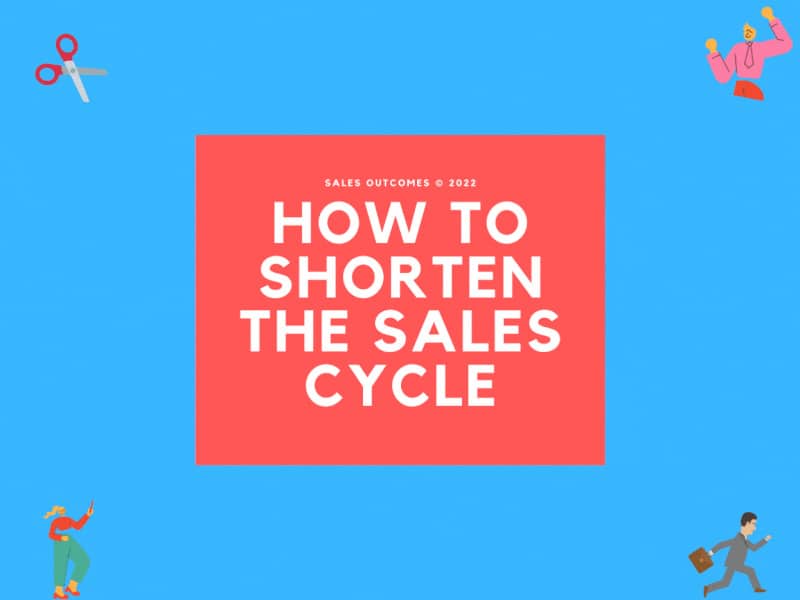Five Approaches to Shorten the B2B Sales Cycle
One reliable strategy for achieving a more predictable B2B close date and win rate is to improve how a deal moves through the sales process and maintains momentum
The Sales Cycle definition is the time it takes to get to a “Yes” or a “No” decision on a deal.
Sure, many factors get in the way of advancing a deal, but ignoring or overlooking sales process activities tends to make the sales cycle longer.
Let’s review five intelligent actions to shorten the sales cycle.
Five Actions to Shorten The Sales Cycle
Five Approaches to shorten the B2B sales cycle
One reliable strategy for achieving a more predictable B2B close date and win rate is to improve how a deal moves through the sales process and maintains momentum.
The Sales Cycle definition is the time it takes to get to a “Yes” or a “No” decision on a deal.
Sure, many factors get in the way of advancing a deal, but ignoring or overlooking sales process activities tends to make the sales cycle longer.
Let’s review five intelligent actions to shorten the sales cycle.
Five Actions to Shorten The Sales Cycle
Salespeople must cultivate confidence and courage to apply actions that many of their most successful peers learned a long time ago. These actions can be used individually or as part of the overall opportunity strategy.
1. Understand and follow the sales process
Salespeople often want to get proposals out quickly. The desire to move fast contributes to losing one’s way during the sales process and skipping essential early-stage activities of a deal where the vital hard work resides.
For example, early-stage sales activities typically include:
– Understanding customer needs.
– Exploring reasons for making a change.
– Identifying factors that may get in the way of change.
We often see salespeople take shortcuts when engaged with a single enthusiastic buyer or when their contact asks for a proposal as soon as possible.
We subscribe to The Law Of The Harvest – popularized by Stephen Covey in the 1990s – which illustrates you can’t take shortcuts if you want to increase your chance of succeeding.
2. Slow down
It may seem counter-intuitive, but slowing down allows salespeople to ask more and better questions, uncover compelling events or reasons for change and listen – which creates the urgency required to speed up the sales process.
It’s okay if the prospect or customer wants to move fast, but slowing down the process in a pragmatic manner can assist in developing confidence in the solution and gaining separation from competitors.
3. Test understanding for the high-level price
Salespeople avoid discussing price, especially for large deals, until they’ve had the opportunity to build the value proposition. Avoiding these discussions can backfire, especially when a customer is contemplating a material change in running the business if your solution is selected.
It makes no sense in consuming time and resources only to discover that the prospect’s expectations don’t match the reality of what they are asking.
The salesperson can say something like, “Solutions that address the type of challenges you are experiencing run between 10 to 20 thousand dollars a month. Is this range close to what you have budgeted or expected?” The answer will allow a salesperson to gauge how educated the buyer may be and understand what it will cost to make a change.
4. Handle objections early
What frequent reasons do companies not buy your solutions? What factors do they consider when comparing your product to a competitor’s?
Instead of avoiding these potential objections until after you’ve delivered a proposal, or hoping they resolve themselves, engage early on the areas that are likely to seed fear, uncertainty, and doubt.
Proactively discussing common objections demonstrates that the salesperson understands how customers evaluate your solutions and make decisions.
5. Leverage marketing content
Sales teams shouldn’t limit prospect engagement to meetings. Sharing marketing content or insight from 3rd party sources is also a form of prospect engagement.
Perhaps you have a prospect concerned with change risk if they select your solution. If you share relevant content from a trusted industry source, you’ll provide independent insight the customer will value, and you’ll have an agenda item for your next meeting.
Independent 3rd party content may carry more weight than internal marketing content. However, work with your marketing team to create materials that provide your firm’s perspective on common prospect concerns.
A combination of internal and external content can expand conversations with the prospect and address factors that may slow down the sales process.
Shortening the sales cycle reduces the time to revenue and can increase the win rate, but it also consumes less sales, sales support resources, and management time.
The best part is that there are almost daily opportunities to shorten the sales cycle. Let’s get started?
